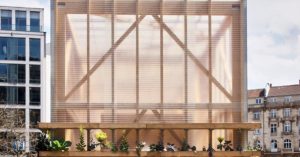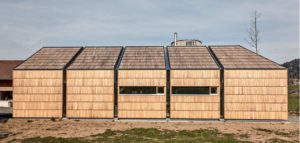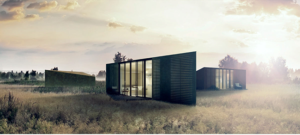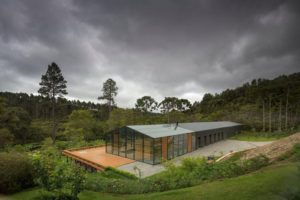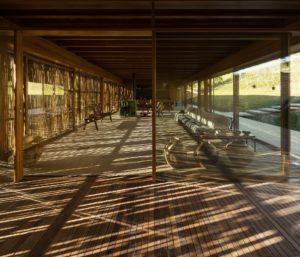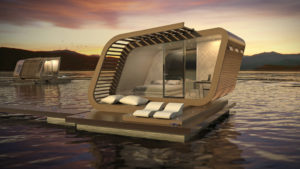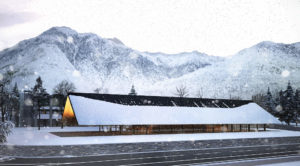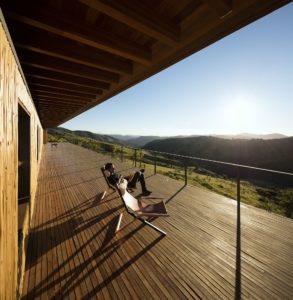A Goetheplatz a Francoforte sul Meno da fine 2015 è presente un padiglione con intelaiatura lungo 30 metri e alto 8 metri realizzato in legno di faggio. Il cosiddetto padiglione “Zukunftspavillon” viene gestito dagli organizzatori di “Architektursommer Rhein-Main” in collaborazione con l’iniziativa Urban Gardening “Frankfurter Garten”. Per un anno la struttura temporanea offre spazio per esposizioni, conferenze e workshop e rimane a disposizione dei cittadini per eventi privati.
Committente Architektursommer Rhein-Main Frankfurt/Offenbach e.V.
Architetto Ian Shaw Architekten BDA RIBA, Francoforte sul Meno
Progettazione strutturale Bollinger + Grohmann, Francoforte sul Meno
Luogo di costruzione Goetheplatz, Francoforte sul Meno
Materiale 45 m³ di Trave BauBuche
Superficie dell’area 225 m²
Ultimazione dei lavori 2015
Fotografie Chris Kister
Con questa struttura in legno di nuova costruzione, la falegnameria ha realizzato un ampliamento di 200 m² agli edifici già esistenti della sua attività. Il piccolo fabbricato aziendale comprende un’officina e una sala espositiva.
Materiale Trave BauBuche GL70
Committente Falegnameria Anton Mohr, Andelsbuch (AT)
Architetto Andreas Mohr, Wien (AT)
Progettazione merz kley partner ZT GmbH, Dornbirn (AT)
Costruzione in legno Kaufmann Zimmerei, Reuthe (AT)
Completamento 2015
Fotografo Christian Grass
La struttura a scheletro dell’edificio consente di configurare gli ambienti in modo molto libero e flessibile. In questo contesto BauBuche viene utilizzato sia come trave che come elemento per soffitto sotto forma di pannello.
Progettazione Lattkearchitekten BDA, Augusta
Materiale Trave BauBuche GL70 e pannello BauBuche
Committente euregon AG
Luogo di costruzione Augusta, Walchstrasse
Ingegneri Bauart Konstruktions GmbH, Monaco
Superficie edificabile 465m²
Superficie dei piani 1.335 m²
Pavimento 310 m² BauBuche Pavimento, trattato con olio
Costruzione/progettazione 2014-2015
Foto Eckhart Matthäus
A maggio 2015 il modulo abitativo “echoWAVE” è stato presentato alla fiera Grand Design Live di Londra. Le sue particolarità: il pavimento, la cucina componibile e una seduta sono stati tutti realizzati in BauBuche. Grazie al contrasto cromatico delle singole tavole del pavimento, lo spazio abitativo ha un aspetto molto vivace.
Design Sam Boothe
Realizzazione echoLIVING per il modulo abitativo “echoWAVE”
Materiale Tavolato BauBuche e pavimento BauBuche
Progetto ANK
team di progetto – Andrea Battistin, Andrea De Faveri, Manuel Marchesin, Mauro Striuli, Giacomo Bianco
committente – S-Unit
superficie 30 mq ca
calendario – 2013 progetto
Il progetto di minihouse ha da sempre esercitato le doti compositive dei più esperti architetti. Incastrare sapientemente in un piccolo spazio le molteplici funzioni dell’abitazione, senza rinunciare al confort dello spazio è la vera sfida che S-Unit ha provato a vincere. Le S-Unit sono case. Unità abitative mobili dalle geometrie essenziali e finiture personalizzabili, in rapporto diretto e simbiotico con l’ambiente esterno. Pensate per sentirsi sempre a casa, anche in vacanza. Un progetto su tre modelli di case prefabbricate in legno dalle elevate prestazioni energetiche, modulari tra loro e modulabili al loro interno, finalizzate al mercato turistico che richiede oramai standard abitativi sempre più prossimi a quelli alberghieri e flessibilità nel medio periodo.
The Mororó House is in a mountainous region, 180 km from the city of São Paulo, known for its low temperatures. The architecture sought to create generous internal spaces for the cold days, such as, for example, a cozy living room and an enclosed bathhouse with a pool, where the views can be appreciated while being protected by a skin of glass.
Externally, the same continuous volume creates a duality between an opaque block – where the living room, bedrooms and service areas are – and the transparent stretch of the heated pool and sauna. The volumetry of the house was given by a sixty-five meters extrusion of an icon-house, with pitched roof. Furthermore, an external wooden deck connects the spaces and creates a solarium to be used during the summer months.
In the opaque part of the volume, which is 50m long, the openings were minimized and used as sliding doors to intensify the integration between inside and out. This relation between empty and full in the façade allows for an excellent thermal performance, with a high degree of electric energy conservation. The transparent stretch is fourteen meters long and the internal ventilation was spatially designed to avoid condensation on the glass by the heated pool, which would harm the relation with the view.
The house was not situated on the top of a rugged site, as initially desired by the clients, but in its lowest part – in the midst of a beautiful forest of pine trees. This solution allowed the building to be surrounded by nature, creating an intimate relation with the site.
The initial premise of the project was to have a quick and cheap construction. Therefore, the architecture found industrialized solutions such as metal structures and steelframe walls. The site, despite high rainfall, remained always clean. Unlike the Brazilian constructive culture, few elements were made entirely on site, but instead mounted or assembled there. The time to build this house was less than the usual, even with the site’s difficult access.
The choice of the materials for the interiors, such as wood, made it a cozy house, like the traditional chalets in the mountains. Following the desires of the future residents, the kitchen could be integrated to the spaces via wooden sliding doors – that could be entirely opened. Thus, it was not only possible to design ample and continuous spaces on the inside, but also to have central spaces for the quotidian life which organized the house plan.
Laid out over the valley, at an altitude of 1,500 meters, the house has a strong relationship with the local nature, abundant throughout most of the year. That allow for autonomy in generating energy. The main premise of the project is to make energy consumption efficient while simultaneously offer comfort to the user, beginning with the simplicity of contact with the local nature.
It’s FSC wooden pre-fab structure, to the point that it remains supported on the land through some pillars, without directly touching the ground, responds well to the necessity of building on a rugged piece of land, far from the city and difficult access. On this, the external ground is a deck also made in certified wood and the internal floor is clay brick made from the local soil. From this same soil the house is made. The divisors of the house are wood frames with woolen insulation of PET which makes it an environmentally correct house. Frames with double windows guarantee the comfort and ventilation. The roof is a wooden platform with vegetation which integrates the house with its surroundings rue composing the area of the land shaded by it. In the vast landscape, the house create a link between that which is built and that which is natural.
The IRIDE 01 Floating Suite was designed to accommodate a comfortable en suite bedroom in 25 square metres. It is suitable for sheltered bays, tourist ports, marine parks, and lakes and it was designed as an annex for lakeside or riverside hotels to offer their guests a unique experience, as an alternative to the traditional accommodation.
Outdoor spaces and wide windows allow for contact with the environment outside, making it possible to appreciate the landscape to the full and enjoy a holiday with high standards of comfort in close contact with nature.
During the day the relationship between inside and outside may be adjusted to pleasure by means of special electronic window opacifiers.
The wooden modular structure on a floating pontoon of about 40 square metres, can vary in length, making it easy to assemble and disassemble, and at the same time limiting costs.
The pontoon consists of a few discontinuous floating units in reinforced concrete with an expanded polystyrene core and it is anchored to the seabed by ground anchors and flexible ropes, the most environmentally-friendly system available as the impact on the seabed is minimal.
The IRIDE 01 Floating Suite, designed for the French company H2orizon, can be purchased singly but it is also the ideal solution for a floating village, where some units can be grouped together and connected to the main building by floating walkways.
Il progetto di riqualificazione della Latteria Sociale Valtellina è l’occasione per restituire una nuova immagine affine all’identità della realtà che contiene e rappresenta, un luogo che ricorda il legame con la tradizione locale e la storia. Il progetto propone una reinterpretazione della malga – la tipologia di costruzione appartenente alla tradizione alpina – con il suo sviluppo in lunghezza, una copertura leggera, un volume su un unico piano, al cui interno trovano spazio i luoghi di vendita, esposizione e lavoro. Un modello che conduce al concetto di tradizione e qualità, il grande tetto si estende per coprire le aree esterne e le rende una naturale prosecuzione degli spazi interni, crea una piazza coperta lasciando intravedere ai passanti ciò che accade all’interno, invitando alla sosta e alla visita.
Concorso a inviti, 1° premio
Postalesio (SO), Italia
2016 – In corso
Committente: Latteria Sociale Valtellina S.C.A.
Superficie costruita: 1.000 mq
Laid out over the valley, at an altitude of 1,500 meters, the house has a strong relationship with the local nature, abundant throughout most of the year. That allow for autonomy in generating energy. The main premise of the project is to make energy consumption efficient while simultaneously offer comfort to the user, beginning with the simplicity of contact with the local nature.
It’s FSC wooden pre-fab structure, to the point that it remains supported on the land through some pillars, without directly touching the ground, responds well to the necessity of building on a rugged piece of land, far from the city and difficult access. On this, the external ground is a deck also made in certified wood and the internal floor is clay brick made from the local soil. From this same soil the house is made.
The divisors of the house are wood frames with woolen insulation of PET which makes it an environmentally correct house. Frames with double windows guarantee the comfort and ventilation. The roof is a wooden platform with vegetation which integrates the house with its surroundings rue composing the area of the land shaded by it. In the vast landscape, the house create a link between that which is built and that which is natural.
This project has received a Platinum Certification by the Green Building Council Brazil, the highest level possible. This is the first Brazilian project to receive such high-level certification.
All the furniture was provided by Prototyp& (prototypesp.com.br)
